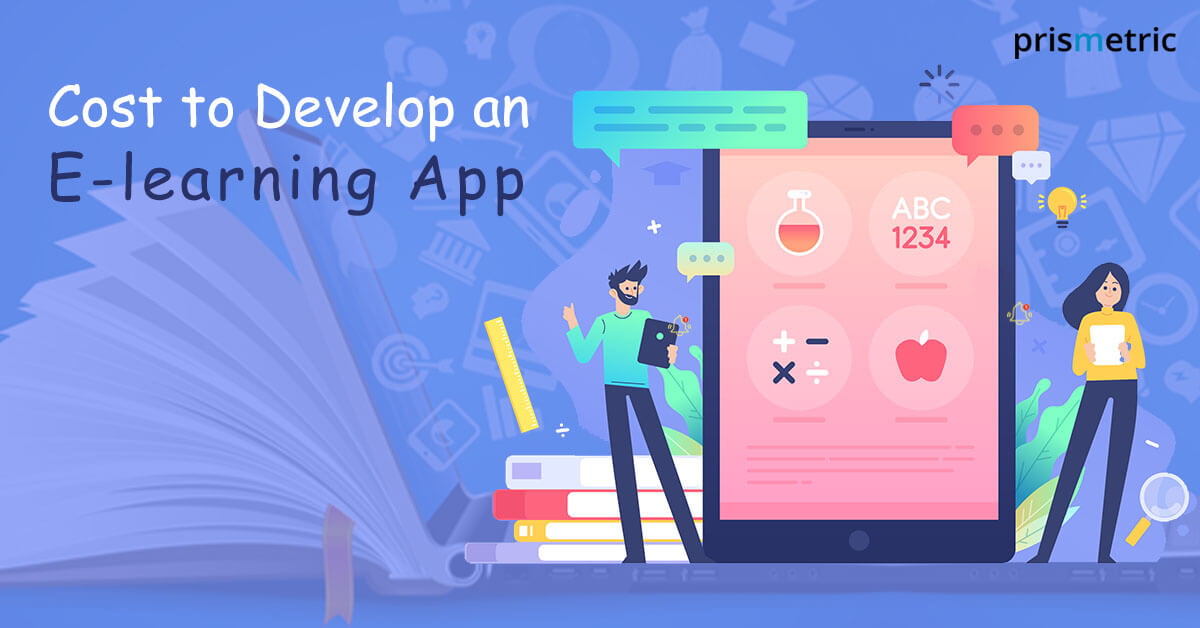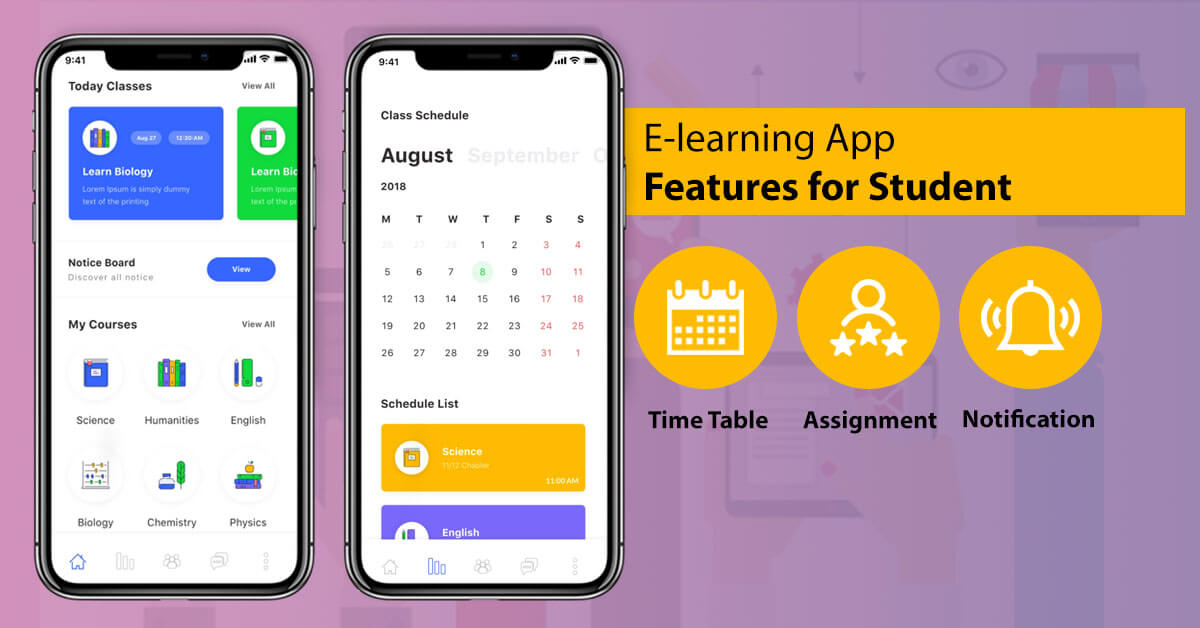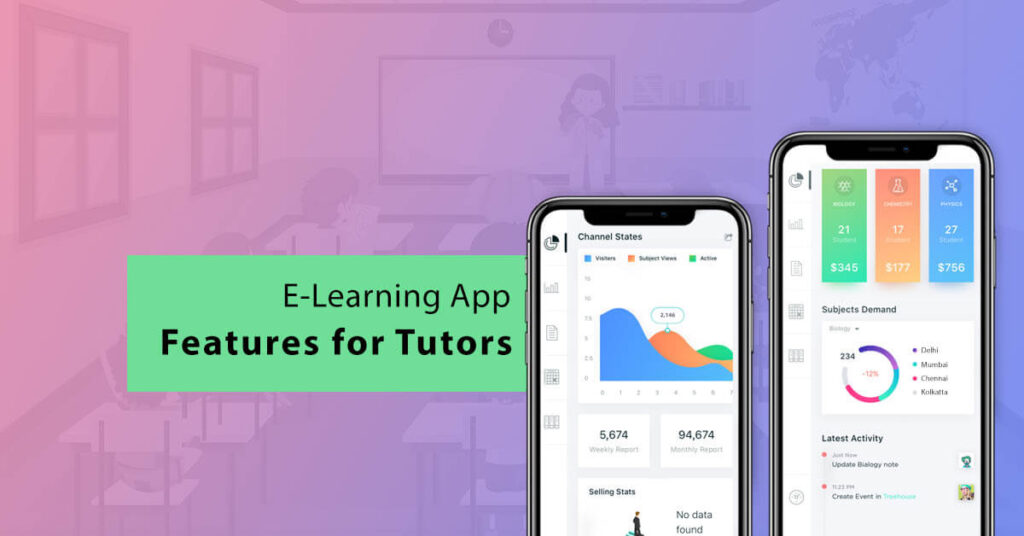perfect apps enriched with latest

E-learning is a simple, location-independent form of learning which uses electronic media as the technology, facilitating fast and widespread dissemination of knowledge. Profound school management systems are opening new avenues for students to get educated and excel in their life.
With internet accessibility spreading to every nook and corner of the world, e-learning has been able to spread its wings. In the past, you had to go to an institution to study. But, at times you were not able to due to
E-learning has helped millions of learners by breaking these barriers. With E-learning, access to knowledge is not bound by location or time as we have entered a new era. And, students, learners, or enrolled users can learn at their own pace from the comfort of their homes.
According to a report by Custom Market Insights (CMI), the global E-learning market size/share is set to grow at 17.53% CAGR creating an incremental growth of $848.1 Billion by 2030.
The physical presence of the tutor has ceased to be a necessity now and catering to new dimensions in learning. With the entrenchment of cost-effective data services and IT hardware, the Education sector is showing unprecedented growth. This growth provides an enormous trove of opportunities for educators.
Flexibility in allowing the users, which mostly comprise students and parents, to learn at their own pace is going to be the biggest driver in the phenomenal growth story of E-learning. Mobile devices are acting as a catalyst in this growth story; learners are becoming more comfortable regarding the use of mobile devices such as smartphones and tablets as learning tools.
Some stats:
The recent corona outbreak mandated students to learn in digital classroom settings, but slowly, it turned out a technology-aided, best learning concept. Now, mobility in education, that’s E-learning application aiming at building a smarter generation in various ways. Such as –
The e-learning apps play a significant role in adding a new frontier to the education industry. It has enabled students from remote areas who cannot travel long distances or can’t spend a high amount on desired education courses to access education easily. In fact, it played a vital role during the latest pandemic when people were forced to stay inside their houses. Here are a couple of ways e-learning apps taking education to the next level.
E-learning apps are providing leeway to the students to stay flexible by choosing the study schedule according to their availability as they can go through courses anytime, anywhere. Also, teachers are free to run classes and only need to inform the students about the class schedule a day before.
Quality education is now accessible to limitless students who cannot travel long distances. The application system for eLearning enables students to get connected with teachers and learn remotely from a convenient location and time.
Education has turned into a profit-making machine that deters students of the low-income groups to get admission to top schools or colleges. Breaking the barrier, the mobile software for E-learning has made education more accessible without spending a lot of money. Students can get benefitted from live classes or pre-recorded classes.
E-learning mobile apps take content delivery to the next level with interactive sessions between teachers and students wherein they can communicate and share their opinions. Students can ask questions and teachers can assist them with their homework in real-time.
Mobile applications for E-learning apps are not limited to academic studies. Instead, the app extends the student’s reach to new courses that help them to master and acquire new skills. It provides insights into various domains other than the curriculum which not only helps them to build a successful career but also provides life lessons as well.
When you plan to partner with an Education and E-learning software development company, you need to do the necessary homework to get the best solution to the table. The pointers you should consider before the development of the mobile app for e-learning are as below-
Before rolling the project on the development floor, researching about app idea uniqueness is all-important. It helps brands to distinguish the app from the crowd. When you got an idea, do competition research that helps you identify the gaps in the market, where to-be-developed e-learning app of yours can get a competitive advantage.
When the e-learning app idea with a list of features is finalized, it’s essential to know the target audience, if it’s students, teachers, or academic professionals. The audience research helps in tailoring content accordingly that intrigue the target audience and enhances the online learning and educational app’s popularity.
You have managed to get build unique functionalities into your e-learning app, but they cannot draw users’ attention unless the interface makes the content easy to consume or navigate through. UI designing forms an important part of mobile app development that you should take seriously.
Minimum Viable Product (MVP) is an initial version of the application including basic feature along with features and functionalities that makes it unique in the market. Create a list of features that you want to include in the MVP of your Elearning platforms, which helps you gain feedback and improve the app the same way.
Every business owner is looking to earn money via their app. It makes perfect sense to plan the different types of monetization models before the launched of your e-learning app so that you can start making money from day one of its release.
In the Synchronous E-learning model, there is real-time communication between the tutor and the student. This communication can be a virtual classroom or a webinar wherein the tutors instruct from their premises, and the students connect with the tutors through the web or mobile app. Doubts and questions can be solved instantly, and students can collaborate with the other students as well based on the features provided in the application. Synchronous E-learning provides the learners with classroom experience from the remote location of their comfort.
Examples of Synchronous learning:
Virtual classroom: Virtual classroom apps enable real-time interaction and collaboration between teachers and students. The apps replicate the classroom environment in digital setup with video conferencing, collaboration features, and participation controls.
Shared whiteboard: Aiming real-time collaboration and interaction, the app enables various e-learning providers to share the whiteboard on a single screen that attracts a wider set of learners.
Examination-based app: This type of e-learning app is especially designed to precisely conduct tests to assess the student’s knowledge and skills. The responses by the student during the online exams are registered and analyzed. After that, it is published by respective teachers instantly.
Asynchronous E-learning does not require the virtual presence of the learner and the tutor. In this mode of E-learning, the tutor or admin uploads the course material and the learners’ progress at their own pace. This mode allows more liberty to the tutor as well as the learner to continue their activities without being directly dependent on the other with aspects regarding respect to time and availability.
Examples of Asynchronous learning:
Course based: Course-based apps are designed to run different types of courses wherein course material is available in text, audio, and video format for improved accessibility.
Smart Connect: The connect-based apps are released to provide exclusive training and teaching material for the teachers that they can access anytime and use during classes as well.
Mobile learning apps: mobile-learning apps are built for short courses and lessons that are easy to access and understandable on mobile screens. UI/UX design soothes everyone’s eye so that learners can access content and get prepare for the exams on the go.
Here are some more popular types of education apps available in app store and play store that one would like to build.
Post-pandemic, the e-learning options emerged as the best medium to learn and teach worldwide. Now, there are lots of companies offering e-learning solutions for learning needs. To help you find the best e-learning app in the world, here’s the list of apps that are mostly used.
Some basic user-friendly features required in the educational mobile app that are accessible to various user roles:



Getting the competitive mode “on” is an effective way of motivating the learners to perform better. An easy way to do this is to add the leaderboard feature in your E-learning app.
Learners should be able to learn various courses and other training material from the elearning app. You have to make sure to include multiple options of courses in your app based on the courses and the materials. This inclusion will have a positive impact on your app earning as well.
Interactive concepts should be incorporated into the app. This addition can include an activity, game, or exercise in which the active involvement of the user is essential. Such engagement will help in sustaining the interest of the student for a more extended period. The inclusion of some of the latest technologies like Augmented Reality (AR) and Virtual Reality (VR) will ensure the delivery of more insightful knowledge and information. Taking a step further, leveraging mixed reality in learning makes e-learning intuitive and promotes self-learning.
Integrating this feature in your app will drive user engagement upwards, as the learners will be able to connect with the tutors in a much better way by attending live classrooms. The video feature will prove helpful in clearing their doubts much faster.
Your E-learning app should have a feature that allows easy file sharing between different learners and also among learners and tutors. This feature will enable the learners to easily exchange notes and other documents so that they can solve their doubts quickly. Along with this, it allows discussion in a forum, wherein users taking the same course can easily connect with each other, share ideas, and collaborate to learn.
The posts in the discussion forum should be moderated by the admin to avoid misuse of the forum, and the users should receive notifications whenever something new is posted.
Incorporating E-learning analytics in an app will provide invaluable insights to the learners regarding the areas where they need to improve. For instance, a student might be good at solving math problems, but it won’t be beneficial if the time taken to solve the math problems exceeds the permitted time.
Analytics help in reducing the users’ dropout ratio and improve training material according to users’ preferences, which gives the instructors a chance to intervene where the learner is facing difficulties in a particular concept.
The analytics is directly linked to various performance metrics like the time spent on the E-learning module, test results of the module, learner progress ratings, and other measurable factors.
From a business perspective, analytics help in retention of the customers, as the online education institution can cater to the needs of their learners in the area where they are facing difficulty.
How could Mobile Analytics show the Path to a Successful App?
Content is the main selling point of any e-learning app. Integrating a content management system will efficiently aid you in keeping the content of your educational app updated and catering to the needs of the students.
It is essential to listen to your customers so that you know where your e-learning mobile application needs improvement. The complaints of your customers can be handled in a better manner if your app has in-app customer support. Hence, it is suggested to integrate CRM (Customer Relationship Management) system into your application. The FAQs can be answered by a single bot using the AI bot architecture to reduce the costs of hiring a human customer service agent.
Gamification of the learning process has successfully proven to improve the involvement of students and employees. See the below stats to look at the mind-boggling numbers clearly depicting the benefits of gamification.
Your e-learning app needs to communicate with the student or learners in order to keep them updated regarding upcoming classes and other updates in the course content. Embedding a push notification feature in your app for learning online can help in achieving this goal.
Revenue generation is an essential part of e-learning apps that cannot be overlooked at any cost. Before building an app for your e-learning business, as an entrepreneur, you should consider the monetization models that can help you to earn money. Here are some of the models that can be implemented in your e-learning app for the same.
A popular way of monetizing your E-learning app is allowing for in-app ads. This method of monetization ensures that the app can be made available for free to users, which often leads to rapid propagation of the app among users. The ads should be relevant to the audience so that they do not come across as being obtrusive.
For example, you can opt for ads related to supplementary course materials from Amazon, or you can allow ads from reputed institutions that provide courses related to the content you are offering.
A basic app is available to all users free of cost in this model and is marketed as a freemium product. This approach ensures that they can get a better idea about the features of the app and decide whether it is the best fit for them and which subscription model to opt for.
Alternatively, you can give the full-featured E-learning app for free to use for a specific number of days.
Another possibility is that you can allow the users to use certain features of the app for free and ask them to pay for premium features. For example, you can allow app users to access the readable material for free; but, if they want to watch the videos, interact with the tutor, or want to download any material, they will need to pay.
Another idea is to allow the users to check the course content by granting them access to the first few lessons for free but asking for payment for the other lessons in the module. The idea is to make the user more comfortable with your E-learning app UI/UX design. Once the user gets hooked onto the free version of the app, the premium version is gently pushed. It can include features like Getting your doubts cleared by instructors
Apart from these, you can add many other benefits for students and teachers as well to choose from and earn money.
As an app owner, you can integrate in-app purchases of courses and materials that are made available either online or offline. The users purchase their favorite courses and pay only for those courses in which they are interested. To hook the users to the app, you can include a feature that allows the user to view about 20% of the content and then take a call on buying the material.
For example, the user can view about 10 min of video content out of the total 45 min, and if interested, then the user can opt to buy the content. The app can have a security feature, which allows viewing the course material only on the app and not anywhere else; this will prevent piracy of the learning material that you are providing.
This monetization strategy steps up the ROI-generation game. Find a suitable partner with an optimal customer base that adds value to your eLearning app and enhances customer experience. The mutual partnership brings a plethora of benefits to the business in terms of improved sales and ROI.
You can also allow brands with similar customer base pay to get a spot and publish the content in the app under the sponsorship umbrella. For instance, educational program or tutorials that are helpful to the users helps in increasing engagement, retention, and revenue as you get a share of what other brands have earned through content publication.
The in-app purchase monetization model turned out as the perfect revenue generation strategy because it can help to build an army of optimal userbases that continuously engage with your application of online learning. For instance, users willingly purchase premium content through in-app purchases when free content appeals to them. Also, the users are allowed to unlock high-level courses after paying a few bucks. You need to understand that the in-app purchase model for monetizing your elearning app works only when it can improve customer experience via purchase.
When the app for eLearning has gained enough customer base, it means customers’ data is captured which can be sold to third parties. The data is helpful to advertisers and analytics companies to identify trends based on user behavior. Make sure, when you are selling data to a reliable monetization partner, follow all the security and privacy rules, or else data licensing is put under scrutiny or subjected to heavy penalties.
Your E-learning app will need the following technology stack to function smoothly.
Cloud Data Storage: Data will be stored on cloud services like Amazon Web Services (AWS), Microsoft Azure, Google Cloud Platform (GCP).
Database: Various tables will be created, and the details entered accordingly. Eg: MySQL
Frontend development: The development at the front end can be bifurcated based on the type:
Frontend iOS Development: Swift, React Native
Frontend Android development: Android studio (Java), React Native
Cross-platform development: Flutter, React Native, Node.js
UI/UX Design: This will include each and every aspect of design right from designing the wireframes to the related images and icons to drafting the perfect user experience. Eg: CSS, HTML for webpage designs & Photoshop, Adobe Illustrator, and Sketch for Mobile applications.
Analytics: Based on the level of analytics to be integrated, you can opt accordingly. Eg: Google Analytics
SMS and verification via phone and voice: These services can be integrated to provide SMS notification and verification services. Eg: Nexmo, Twilio.
Email Management: You can manage everything related to email right from registration to resetting passwords to communication for every aspect. Eg: Mandrill, Sendgrid, Mailjet, AmazonSES, and Mailgun.
Augmented Reality and Virtual Reality: AR and VR technologies are among the trending ones that have improved engagement and provided a better understanding of various aspects to the learners improving the overall experience of using the e-learning app as a user.
Payment Gateways: To be used for providing an efficient in-app payment model. Focus on integrating the most common as well as multiple payments mode to make the payments so that the user can opt for the most convenient one. Eg: Credit/Debit Cards, e-wallet, PayPal, Net-banking, Braintree, and Stripe.
Streaming video: Video streaming feature can be integrated by using services like Agora.io, RTMP, webRTC

The E-learning app development team generally consists of
The cost of simple e-learning app with basic features will range from $16000 to $30000, while an app with all the bells and whistles such as a complex e-learning app development cost starts from $40,000 and it will increase based on the advanced features you opt to integrate.
The cost to develop an e-learning application depends on various factors:
Tip: The Cost to hire developers depends on the country from which you are getting your app developed.
Here is a rough idea of the hours it will take to integrate certain functions:
Remember that the above figures for time and cost are just estimates, and will vary according to the complexity of the app. For example, the development budget for an app would skyrocket if you want it to support millions of documents and video uploads or if you want to integrate AR and VR technologies into your app.
Along with the development costs, you will need to take into consideration certain post-development costs, like Bug fixes, App Store publishing fees, emergency app maintenance fees, and app hosting fees. If you are still unsure, the client’s guide to development cost estimation for different applications would help understand how the cost fluctuates.
e-learning app development is an expensive affair, but sometimes, entrepreneurs end up paying huge sums of money, which can be prevented. Well, reducing the development costs of e-learning apps doesn’t mean compromising quality or experience. Instead, it’s about avoiding all the unnecessary features that deliver value to the users.
Outsourcing app development is also a way to reduce cost, where the location of the dedicated development team working remotely influences the price to build. But even, if you have selected the right company, a couple of mistakes end up with businesses outspending for the e-learning app development that is-
Businesses can avoid making over-payments on things that are unnecessary with an intelligent decision backed by knowledge and experience. Considering all of the aforementioned factors, the e-learning app development cost can be controlled.
The businesses when done with target audience research and market research, get crafted optimal UI, plan for monetization model proactively, and go ahead with MVP- getting build an e-learning app within time and budget becomes feasible as you follow an appropriate app development guide.
You will need professional mobile app developers to aid you in realizing your dream of developing an excellent E-learning app. A partner who has a good reputation in the field of mobile app development and has a robust team that will ensure that you do not have a headache while developing the e-learning app.
E-learning app development is a step-by-step process that includes- target audience research, selecting the e-learning app’s type, enlisting features, partnering with an ideal development company, and launching MVP.
Basically, education apps are built for students and teachers, but when we dig deeper, you will find a bunch of sub-categories. Here are some of the most popular types on which one can build an application.
A basic e-learning app development cost ranges from $16,000 to $30,000 for two platforms and the budget for a complex e-learning app starts at $40,000.
Different e-learning apps consider various monetization strategies to grow revenue and profits that are- freemium, paid apps, advertisement, in-app purchase, online selling, subscription, and more.
You need to create features separately for students, teachers, parents, and the admin interface. Read the blog to know which features are essential for every interface development.
Know what’s new in Technology and Development